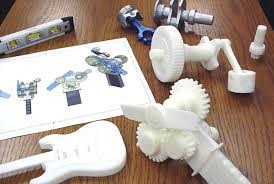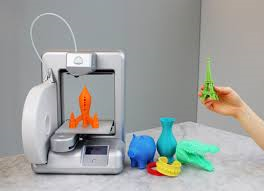 Items made by 3 D printer Items made by 3 D printer The 21st century has its own form of “alchemy” in 3-D printing, which also includes improving quality of life and prolonging life. This miraculous device is capable of making everything from artificial human hearts to a pair of pliers--all out of plastic. But now the science is going farther to include using metals exploding the field into endless possibilities. Alchemy was the medieval chemical science and speculative philosophy claiming to achieve the transmutation of base metals into gold, discover a universal cure for disease, and the discovery of a means of indefinitely prolonging life. The alchemist was sought after as the magician whose powers were mysterious and alluring. The 21st century has its own form of “alchemy” in 3-D printing, which also includes improving quality of life and prolonging life. This miraculous device is capable of making everything from artificial human hearts to a pair of pliers--all out of plastic. But now the science is going farther to include using metals exploding the field into endless possibilities. 3D print structures can be constructed of copper and gold according to new research. The process involves stacking microscopically small metal droplets. These droplets are made by melting a thin metal film using a pulsed laser. The field is advancing and occasionally referred to as the “new cornerstone of the manufacturing industry,” according to Science Daily. If metals could be used for 3D printing , this would broaden the range of applications. Metals conduct electricity and heat efficiently and are very robust. Therefore, 3D printing in metals opens the field to manufacturing of entirely new devices and components, such as small cooling elements or connections between stacked chips in smart phones, as a few examples. Reported in 3Dprint.com, one area of research outlined progress in ‘Toward 3D Printing of Pure Metals by Laser-Induced Forward Transfer,’ and published in Advanced Materials, an entirely new approach to printing with metals. The new process, which relies on a technique called Laser-Induced Forward Transfer (LIFT), requires no metal powders and functions like nothing seen before. The Laser-Induced Forward Transfer process utilizes a high powder pulse laser and a metal film suspended from a clear substrate. The laser pulse is then focused onto the film, which liquefies upon being struck by the laser. When the heat of the laser makes contact with the metal film, the metal rapidly heats up and a phase change occurs. This phase change provides the propulsion necessary to rapidly propel the liquefied metal towards a receiving substrate or build a platform, they noted. 3D Printing at the international space station 3D Printing in a Zero-G Technology experiment demonstrates that a 3D printer works normally in space. In general, a 3D printer extrudes streams of heated plastic, metal or other material, building layer on top of layer to create 3 dimensional objects. Testing a 3D printer using relatively low-temperature plastic feedstock on the International Space Station is the first step towards establishing an on-demand machine shop in space, a critical enabling component for deep-space crewed missions and in-space manufacturing, according to the NASA website. Watch the YouTube video about the 3D printer here that is going to be the first ever used in space.  3D printing in the future of manufacturing The technology has developed to the point of rethinking industry. The next industrial revolution will be opening up manufacturing to the whole world – where everyone can participate in the process. Industrial democratization will be similar to the journey computers had – from a few, big, centralized mainframes to the versatility of a smart phone, reported by the Christian Science Monitor Desktop 3D printing manufacturing technology can be done at home, the office, a hospital or a school, bringing manufacturing to non-manufacturers the way PCs brought computing to non-traditional environments. I shopped around to investigate availability and how much a 3D printer costs. The internet is awash with resources to buy them in almost every price range imaginable. Best Buy, a large warehouse-style company in the US, had them for as much as $6,499.99 for the MakerBot Replicator to $977.99 for the Flashforge-Creator. Amazon.co.uk had a desk top 3D printer for 329.00 and a Flashforge Creator for 825.00—both prices are British pounds, not US. Soon 3D printers will be standard home computing equipment—waiting for the next generation of inventions. Buying a standard computer printer 15 years ago positioned the home user among the avant garde, but now one must own a 3D printer to at least compete in the changing technological world which seems to be advancing faster than my yearly birthdays. Resources Science Daily CSC
0 Comments
Leave a Reply. |
Dava Castillo
is retired and lives in Clearlake, California. She has three grown
children and one grandson and a Bachelor’s degree in Health Services
Administration from St. Mary’s College in Moraga California. On the
home front Dava enjoys time with her family, reading, gardening, cooking
and sewing. Archives
November 2015
|


